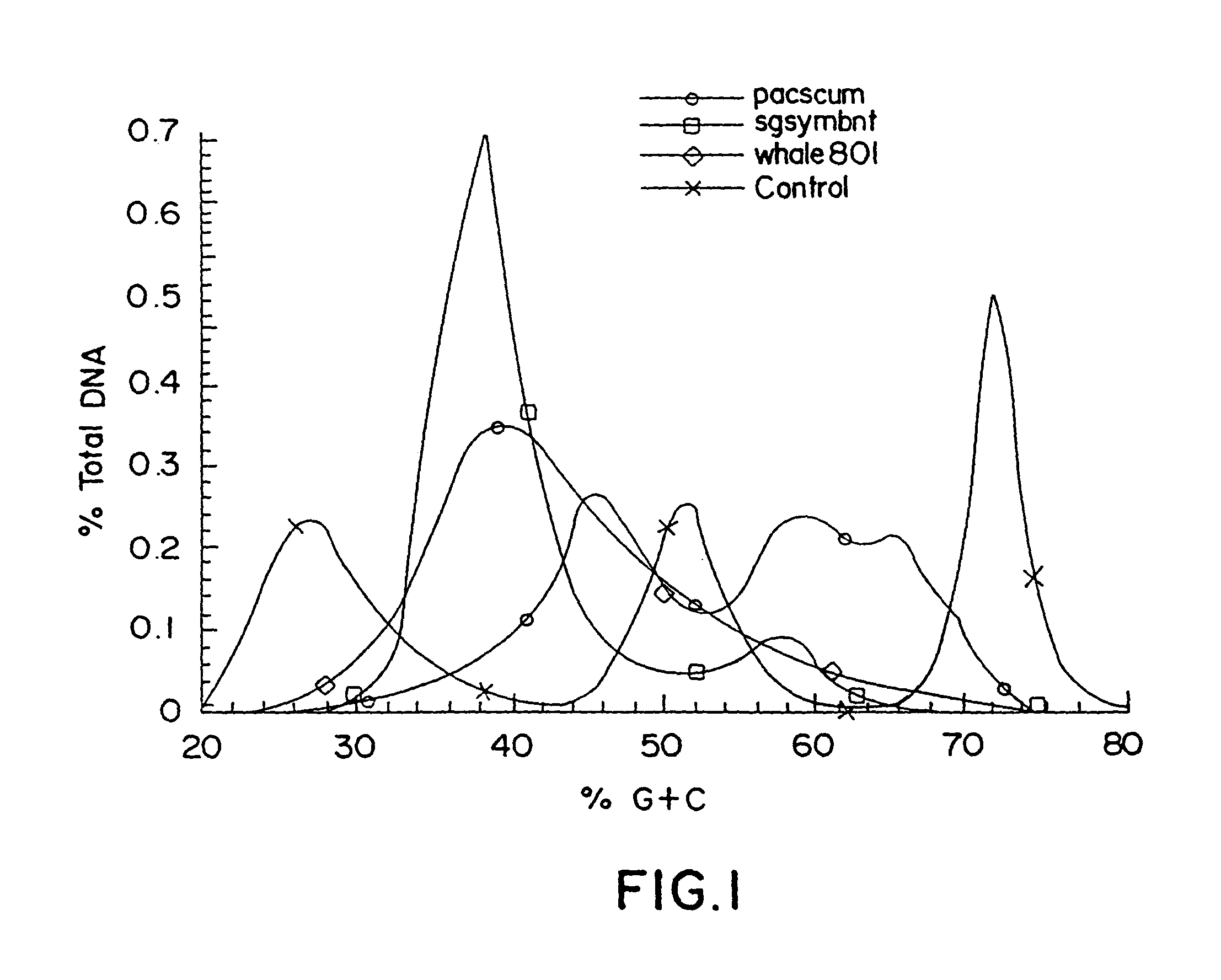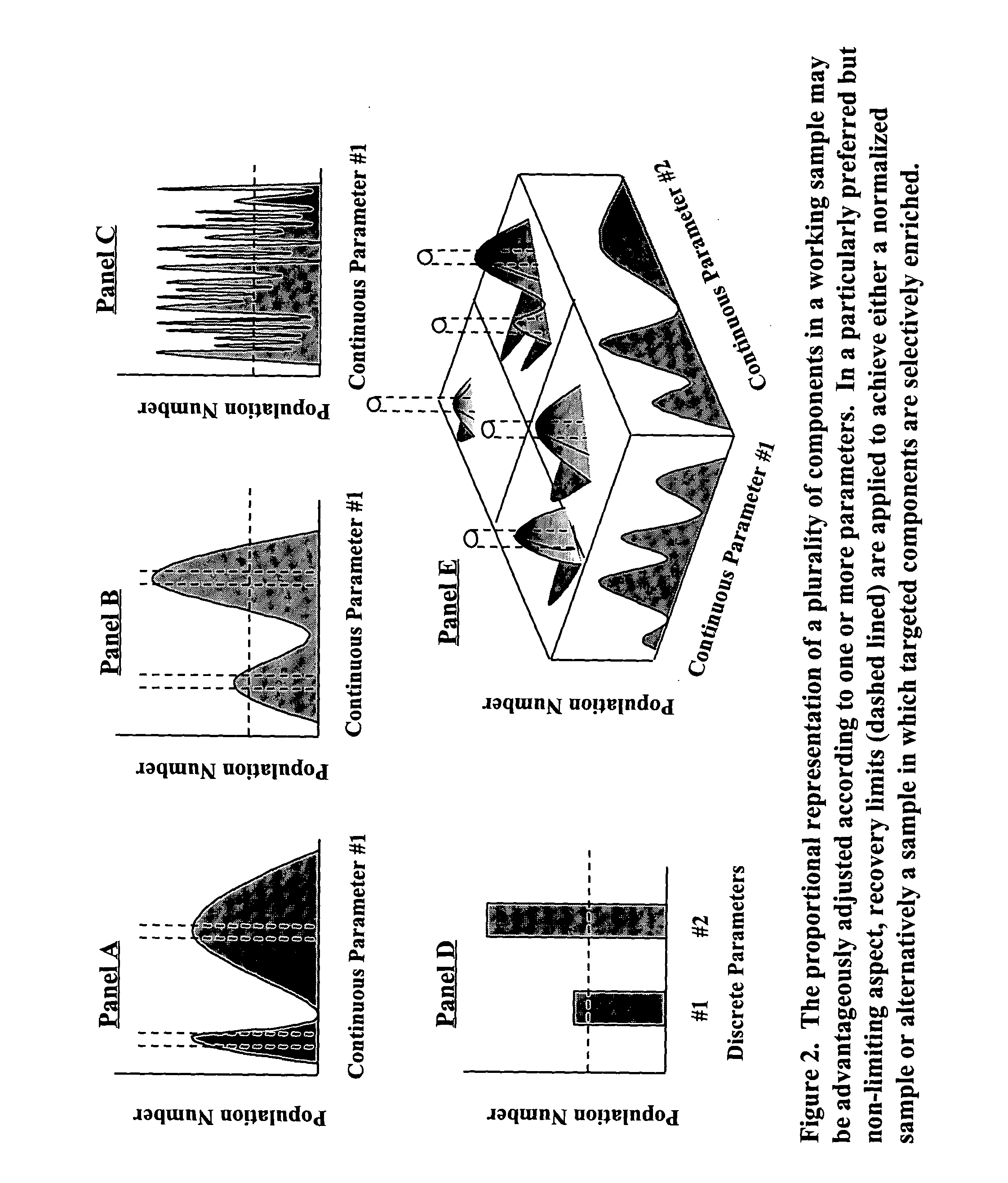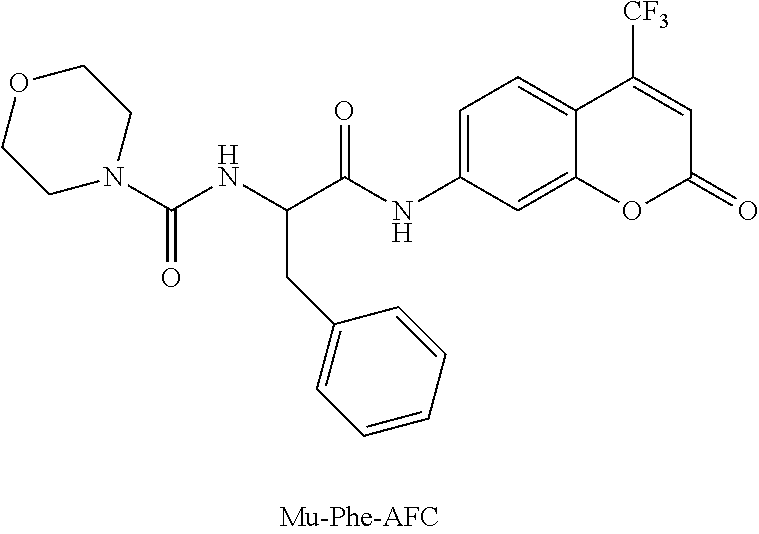Construction and use of catalogued nucleic acid libraries that contain advantageously adjusted representations of defined components
a nucleic acid library and library technology, applied in the field of nucleic acid library production and screening, can solve the problems of difficult to isolate nucleic acids from libraries, difficult to achieve, and often difficult and painstaking approaches
- Summary
- Abstract
- Description
- Claims
- Application Information
AI Technical Summary
Benefits of technology
Problems solved by technology
Method used
Image
Examples
example 1
Extraction and Cleaning of Organisms from Soil (for Subsequent DNA Extraction)
[0146]The extraction method of Example 1 is based upon published methods (Holben, 1994; Rickwood, 1982) and comprises novel modifications.
A) Reagents:
1. Extraction buffer:
[0147]
MgSO4 × 7 H2O2.5 gmNaCl1.25 gmK2HPO42.5 gmAscorbic acid0.2MH2O1.0 L
2. Acid-washed polyvinylpolypyrrolidone (PVPP):[0148]Add 300 gm of PVPP to 4 L of 3 M HCl, stir overnight. Filter suspension through several layers of cheesecloth (use large Buchner funnel). Wash with 4 L distilled H2O, 4 L of a 20 mM potassium phosphate buffer (pH 7.4). Repeat washes with phosphate buffer until pH is 7.0. Spread the PVPP on lab paper and let air dry overnight.
3. Nycodenz-solution:
[0149]8 gm Nycodenz in 10 ml distilled H2O.
B) Procedure:
[0150]1. Combine in a blender jar:
[0151]50 g soil
[0152]15 g acid-washed PVPP (polyvinylpolypyrollidon)
[0153]200 ml extraction buffer[0154]2. Homogenize for three 1-min intervals with 1 min cooling in an ice bath bet...
example 2
Genomic DNA Isolation
[0166]1. Samples are resuspended directly in the following buffer:[0167]500 mM Tris-HCl, pH 8.0[0168]100 mM NaCl[0169]1 mM sodium citrate[0170]100 g / ml polyadenosine[0171]5 mg / ml lysozyme[0172]2. Incubate at 37 C for 1 hour with occasional agitation.[0173]3. Digest with 2 mg / ml Proteinase K enzyme (Boehringer Mannheim) at 37 C for 30 min.[0174]4. Add 8 ml of lysis buffer [200 mM Tris-HCl, pH 8.0 / 100 mM NaCl / 4% (wt / vol) SDS / 10% (wt / vol) 4-aminosalicylate] and mix gently by inversion.[0175]5. Perform three cycles of freezing in a dry ice-ethanol bath and thawing in a 65 C water bath to release nucleic acids.[0176]6. Extract the mixture with phenol and then phenol / chloroform / isoamyl alcohol.[0177]7. Add 4 grams of acid-washed polyvinylpolypyrrolidone (PVPP) to the aqueous phase and incubate 30 minutes at 37 C to remove organic contamination.[0178]8. Pellet PVPP and filter the supernatant through a 0.45 m membrane to remove residual PVPP.[0179]9. Precipitate nucleic...
example 3
CsCl-Bisbenzimide Gradients
Gradient Visualization by UV:
[0183]Visualize gradient by using the UV handlamp in the dark room and mark bandings of the standard which will show the upper and lower limit of GC-contents.
Harvesting of the Gradients:
[0184]1. Connect Pharmacia-pump LKB P1 with fraction collector (BIO-RAD model 2128).[0185]2. Set program: rack 3, 5 drops (about 100 μl), all samples.[0186]3. Use 3 microtiter-dishes (Costar, 96 well cell culture cluster).[0187]4. Push yellow needle into bottom of the centrifuge tube.[0188]5. Start program and collect gradient. Don't collect first and last 1-2 ml depending on where your markers are.
Dialysis[0189]1. Follow microdialyzer instruction manual and use Spectra / Por CE Membrane MWCO 25,000 (wash membrane with ddH2O before usage).[0190]2. Transfer samples from the microtiterdish into microdialyzer (Spectra / Por, MicroDialyzer) with multipipette. (Fill dialyzer completely with TE, get rid of any air bubble, transfer samples very fast to avo...
PUM
| Property | Measurement | Unit |
|---|---|---|
| depth | aaaaa | aaaaa |
| length | aaaaa | aaaaa |
| concentration | aaaaa | aaaaa |
Abstract
Description
Claims
Application Information
 Login to View More
Login to View More - R&D
- Intellectual Property
- Life Sciences
- Materials
- Tech Scout
- Unparalleled Data Quality
- Higher Quality Content
- 60% Fewer Hallucinations
Browse by: Latest US Patents, China's latest patents, Technical Efficacy Thesaurus, Application Domain, Technology Topic, Popular Technical Reports.
© 2025 PatSnap. All rights reserved.Legal|Privacy policy|Modern Slavery Act Transparency Statement|Sitemap|About US| Contact US: help@patsnap.com



